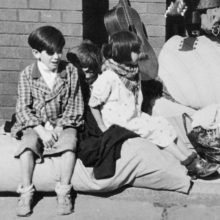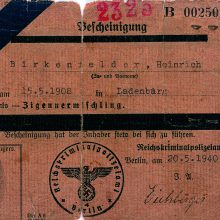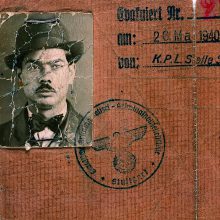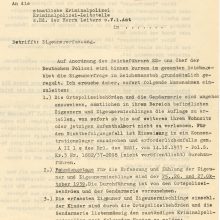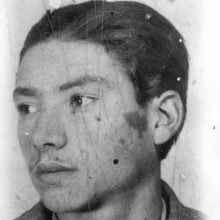The first deportations to occupied Poland
On 21 September 1939, an SS conference convened and headed by Reinhard Heydrich decided on the deportation of all 30,000 Sinti and Roma from the Reich territory to occupied Poland. As a preparatory measure, Himmler issued a ‘Festschreibungserlass’ [‘confinement order’] on 17 October 1939, prohibiting all Sinti and Roma from leaving their place of residence under threat of imprisonment in concentration camps.
Six months later, on 27 April 1940, Himmler ordered the deportation of 2,500 Sinti and Roma to the ‘Generalgouvernement Polen’ [‘General Government of Poland’]. Assembly camps were set up in Hamburg, Cologne and Asperg near Ludwigsburg. From there the deportation trains transported the Sinti and Roma families directly to the forced labour camps in occupied Poland.
01 | Himmler in a speech to Gauleiter [regional Nazi Party leaders] and other party functionaries in Berlin on 29.2.1940
01
02.1 | Deportation of the Sinti and Roma from the Hohenasperg assembly camp to occupied Poland on 22 May 1940 Federal Archives, R 165 photo 244-42
02.1
02.2 | Deportation of the Sinti and Roma from the Hohenasperg assembly camp to occupied Poland on 22 May 1940 Federal Archives, R 165 photo 244-55
02.2
03.1 | The Cologne exhibition halls were also used as a provisional assembly camp for deporting Sinti and Roma families to occupied Poland. Documentation Centre Archives
03.1
03.2 | The Cologne exhibition halls were also used as a provisional assembly camp for deporting Sinti and Roma families to occupied Poland. Documentation Centre Archives
03.2
04.1 | Heinrich and Amalie Birkenfelder were deported to Poland in May 1940 along with their four children, including Max, pictured here. A fifth child was born there, but died a short time later as a result of the inhumane living conditions. The photograph with their two daughters Sonja and Senta was taken at the […]
04.1
04.2 | Amalie Birkenfelder with her son Max. Documentation Centre Archives
04.2
04.3 | Sonja and Senta, the two daughters of the Birkenfelder family. The photo was taken in the Radom ghetto. Documentation Centre Archives
04.3
04.4 | ‘Certificate’ for Heinrich Birkenfelder, issued at the Hohenasperg assembly camp. The document bears the signature of Josef Eichberger of the Berlin Reich Criminal Police Department. Front, Documentation Centre Archives
04.4
04.5 | ‘Certificate’ for Heinrich Birkenfelder, issued at the Hohenasperg assembly camp (back). Back, Documentation Centre Archives
04.5
04.6 | Excerpt from the list of names of Sinti and Roma from Ludwigshafen who were deported to occupied Poland in May 1940, including members of the Birkenfelder family (see photos) Ludwigshafen Municipal Archives, ZR II 2173, 26
04.6
04.7 | Excerpt from the list of names of Sinti and Roma from Ludwigshafen who were deported to occupied Poland in May 1940, including members of the Birkenfelder family (see photos). Ludwigshafen Municipal Archives, ZR II 2173, 28
04.7
05 | Maria Theresia Lehmann at her confirmation in April 1940. A few weeks later she was deported to occupied Poland along with her family. Hartmut Bohrer
05
06 | Maria Winterstein was among the victims of the deportation from south-west Germany in May 1940. Documentation Centre Archives
06
07 | Richard Reinhard, taken shortly before his deportation to occupied Poland Documentation Centre Archives
07
08.1 | Hermann Kreutz, who had served as a soldier in the First World War, was sent to the detention camp for ‘gypsies’ in Düsseldorf-Höherweg along with his family and then deported to occupied Poland in May 1940. Four of his twelve children died in Poland, including Renaldi Kreutz, also pictured. Documentation Centre Archives
08.1
08.2 | Renaldi Kreutz Documentation Centre Archives
08.2
09 | Urgent instruction issued by the Reich Main Security Office dated 17 October 1939: ‘Re: registration of gypsies’ ‘(…) to order all gypsies and gypsies of mixed blood in your area not to leave their place of residence or current location, this with immediate effect and until further notice.’ Munich State Archives, LRA 199580 […]
09
10.1 | Urgent instruction issued by the Reichsführer-SS dated 27 April 1940: ‘Re: resettlement of gypsies’ ‘The first transport of gypsies to the General Government is to get underway in mid-May and will comprise 2,500 people (…).’ BayHStA, MInn 72579
10.1
10.2 | Urgent instruction issued by the Reichsführer-SS dated 27 April 1940: ‘Re: resettlement of gypsies’ BayHStA, MInn 72579
10.2
11 | Olanda Guttenberger Krausnick, Michail: Abfahrt Karlsruhe, Ubstadt-Weiher 2015, p. 16
11



